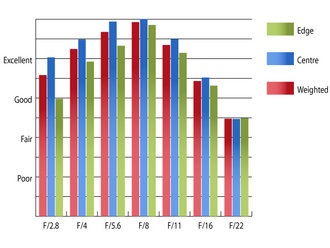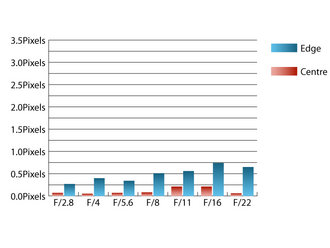Nikon AF-S DX Micro NIKKOR 40mm f/2.8 Lens Review
Nikon Micro 40mm f/2.8 Performance
At maximum aperture the clarity in the central portion of the frame is already excellent and the quality towards the edges is just a shade below good levels.Stopping down improves sharpness further across the frame until f/8, where the clarity is outstanding across the frame. After this diffraction takes a bite out of the sharpness, but the clarity is still good down to f/16.
 |  | |
How to read our chartsThe blue column represents readings from the centre of the picture frame at the various apertures and the green is from the edges. Averaging them out gives the red weighted column.The scale on the left side is an indication of actual image resolution. The taller the column, the better the lens performance. Simple. For this review, the lens was tested on a Nikon D300 using Imatest. | How to read our chartsChromatic aberration is the lens' inability to focus on the sensor or film all colours of visible light at the same point. Severe chromatic aberration gives a noticeable fringing or a halo effect around sharp edges within the picture. It can be cured in software.Apochromatic lenses have special lens elements (aspheric, extra-low dispersion etc) to minimize the problem, hence they usually cost more. For this review, the lens was tested on a Nikon D300 using Imatest. |
Chromatic aberrations are kept to low levels, with them peaking at 0.74pixel widths at f/16 towards the edges of the frame. This low level shouldn't pose any issues, even in large prints or harsh crops from the edges of the frame.
Falloff of illumination towards the corners is very well controlled. At maximum aperture, the corners are only 1.07 stops darker than the centre of the frame and stopping down to f/5.6 results in visually uniform illumination.
As you might expect for a fixed focal lens, distortion is virtually negligible. Imatest managed to pick up 0.253% barrel distortion, which is a very low level and it shouldn't be noticeable under most shooting conditions. If no distortion at all can be tolerated, then it should eb easy to correct in image editing software afterwards, as the distortion pattern is consistent across the frame.
When the lens is focused to infinity, the front element is heavily recessed within the lens barrel, which does an excellent job of preventing light sources from out side the frame causing flare and loss of contrast. A relatively deep circular lens hood is also provided for further protection. When shooting into very strong light sources in the frame, such as the sun, contrast holds up well and the lens rarely causes any flare in the image.
Add your message
Login required
Please login here or if you've not registered, you can register here. Registering is safe, quick and free.
Please login here or if you've not registered, you can register here. Registering is safe, quick and free.
photodo Stats
1102 lenses
428 MTF tests
74 in-depth photodo reviews
100+ users join each day
Help the lens community by reviewing or rating a lens today via our lens search
428 MTF tests
74 in-depth photodo reviews
100+ users join each day
Help the lens community by reviewing or rating a lens today via our lens search
Latest Lens Reviews
- Chinon 28mm f/2.8 Vintage Lens Review
- Canon EF 70-200mm f/4L IS II USM Lens Review
- Samyang AF 85mm f/1.4 EF Review
- Sigma 70mm f/2.8 DG Macro Art Review
- Samyang AF 24mm f/2.8 FE Review
- Meike 50mm f/1.7 Review
- Tamron 70-210mm f/4 Di VC USD Review
- Lensbaby Burnside 35mm f/2.8 Review
- Asahi Super Takumar 50mm f/1.4 Review
- Asahi Super-Multi-Coated Takumar 135mm f/3.5 Review
